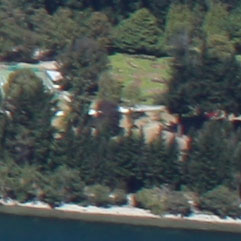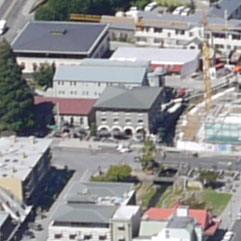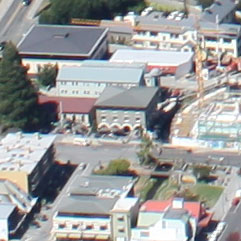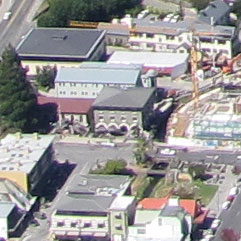Panasonic Lumix DMC-G1
-
-
Written by Gordon Laing
Panasonic G1 vs Canon EOS 450D / XSi vs PowerShot SX10 IS
Panasonic Lumix DMC-G1 results continued…

 |
Real-life resolution
|
To compare real-life performance we shot the same scene with the Panasonic Lumix DMC-G1, Canon EOS 450D / XSi and the Canon PowerShot SX10 IS within a few moments of each other using their best quality JPEG and lowest ISO settings. The lenses on each camera were adjusted to deliver the same vertical field of view. The image left was taken with the Panasonic Lumix DMC-G1 at 100 ISO with the VARIO G 14-45mm kit lens at 18mm f8; the original Large Fine JPEG measured 5.51MB. The crops are taken from the upper left, centre, lower right and lower left portions of the originals and presented here at 100%. |
Note the Canon 450D / XSi captures wider 3:2 aspect ratio images, so by matching the vertical field of view, we’re effectively treating the DSLR here as a 10.8 Megapixel camera, delivering 4:3 shaped images.
With the Lumix G1 set to record 4:3 images at its sensor’s native aspect ratio, it has a small theoretical resolution advantage here, sporting 12 Megapixels. This is measurable in our studio chart results on the next page, but here in a real-life situation, it doesn’t make a significant difference. While the G1 arguably enjoys a very slight edge for pixel-peepers in the crops below, all three cameras are delivering roughly the same degree of real-life detail – most of the visible differences are down to processing strategies and optical quality.
With its default settings and Standard Film Mode, the G1 is delivers a natural-looking result below that employs a modest degree of sharpening; the 450D / XSi’s default processing is a little punchier, and the SX10 IS unsurprisingly the liveliest of all three – this is particularly apparent in the second row of crops. While the SX10 IS is delivering punchier-looking results with its default settings though, there’s no more detail in there, and if desired you can of course boost the output from the other models. It does however also prove that a decent non-DSLR set to its lowest ISO can deliver very similar-looking output under ideal conditions; the differences in quality greatly separate at higher ISOs though as you’ll see on our third results page.
Beyond processing strategies, there’s differences in the optical quality of each system tested. The Lumix G1 with its VARIO G 14-45mm kit lens is impressively sharp up to the corners, unlike our sample of the Canon EF-S 18-55mm IS kit lens which looks relatively soft in the third row of crops. The Panasonic lens also looks impressively free of any coloured fringing, although the camera applies digital correction to JPEGs. We compared the in-camera JPEG to a matching RAW file, and found there was a small amount of fringing visible on the unprocessed RAW file, but still very little to worry about. Despite its diminutive size, the VARIO G 14-45mm lens is a respectable performer, and you can see more samples on our Gallery page.
Scroll down to the bottom of this page to see a sample of the same image taken in RAW, or head straight over to our results from a controlled environment in our Lumix G1 Studio Resolution page.
Panasonic Lumix DMC-G1 |
Canon EOS 450D / Rebel XSi |
Canon PowerShot SX10 IS | ||
 |
 |
 | ||
f8, 100 ISO |
f8, 100 ISO |
f4, 80 ISO | ||
 |
 |
 | ||
f8, 100 ISO |
f8, 100 ISO |
f4, 80 ISO | ||
 |
 |
 | ||
f8, 100 ISO |
f8, 100 ISO |
f4, 80 ISO | ||
 |
 |
 | ||
f8, 100 ISO |
f8, 100 ISO |
f4, 80 ISO |
Panasonic Lumix DMC-G1: JPEG versus RAW
We photographed the scene here in the Lumix G1’s RAW plus Fine JPEG mode, allowing us to directly compare images created from exactly the same data. Below are 100% crops taken from the original JPEG file alongside the RAW version, processed with the supplied Silkypix Developer Studio 3.0SE software using its default settings. Judging from the crops below, the processed RAW file appears softer and less defined than the in-camera JPEG – it could certainly handle a boost in sharpness and contrast if desired. Shooting in RAW does of course offer a wealth of subsequent processing options, and Silkypix includes a number dedicated to correcting lens aberrations including coloured fringing. But the bottom line is if you’re expecting a significantly better-looking result with RAW using the default settings from Silkypix, you may be disappointed. As always, alternative RAW converters may deliver superior results. Now let’s look at the Lumix G1’s resolution in a studio environment. |
Panasonic Lumix DMC-G1: JPEG |
Panasonic Lumix DMC-G1: RAW | |
 |  | |
f8, 100 ISO |
f8, 100 ISO |




